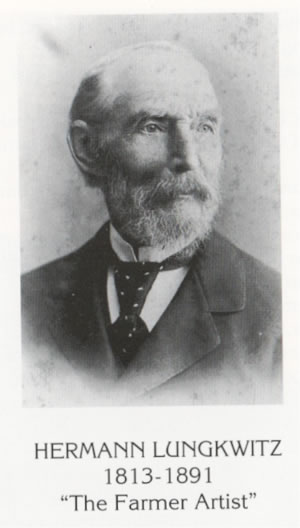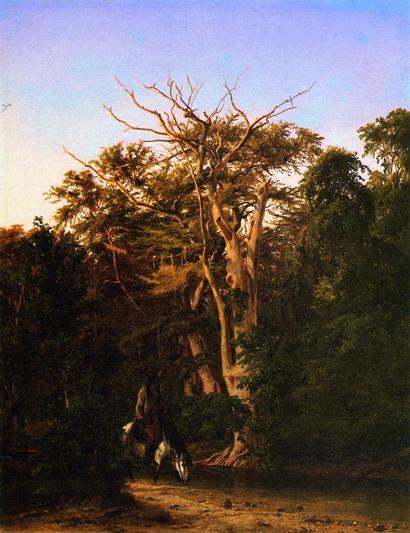Books by
Michael Barr
Order Here: |
|
Had
artists Hermann Lungkwitz and Richard Petri stayed in their native
Germany, their names may have been buried under an avalanche of other
artists with similar training and talent. Instead they came to Fredericksburg,
where their drawings and paintings became some of the first pictorial
records of the Texas
Hill Country.
Hermann Lungkwitz was born in Saxony in 1813. He met fellow artist
Richard Petri while both men were students at the Royal Academy of
Fine Arts in Dresden. Lungkwitz later married Petri's sister Elisabeth.
In 1840s both men got caught up in an insurrection against the Saxon
King. When the revolution failed, Lungkwitz and Petri, fearing retaliation,
immigrated to America.
In 1850 Lungkwitz and Petri, along with members of their immediate
families, sailed to New York. From Manhattan they traveled south to
Virginia but stayed there only a short time. Petri had lung trouble
and found the Virginia climate not to his liking. So they sailed on
to New Orleans; then traveled by steamer to Indianola
and by oxcart to New
Braunfels. In 1852 they bought a farm southwest of Fredericksburg. |
 |
Hermann Lungkwitz
Photo
courtesy Gillespie County Historical Society. |
Richard Petri
Photo
courtesy Gillespie County Historical Society. |
Lungkwitz
and Petri were academically trained painters and illustrators, but
they found it impossible to make a living as artists. The market for
their work was limited. A more immediate problem was that supplies,
especially paper, canvas and oil paints, were hard to come by on the
Texas frontier.
So between chores on the farm, they scribbled and sketched on any
scrap piece of paper they could find. Petri drew and painted on flyleaves
of books and on the reverse sides of award certificates he won back
at the academy in Dresden.
Petri sketched precise portraits of family and friends and scenes
of pioneer life. He drew wonderful pictures of Native Americans. His
work is important not only for its artistic quality but for its correctness
and intimacy. Petri's natives were not wild-eyed savages, but sensitive,
dignified human beings.
Of the 2 artists, Petri is less celebrated because his career was
short. He was already sick with tuberculosis when he arrived in Texas.
He drowned in the Pedernales River in 1857. He went there to calm
a fever, but his body, ravaged by disease, was too weak to fight the
current. He is buried in the Lungkwitz-Petri Family Cemetery in Gillespie
County. |
 |
Meanwhile Hermann
Lungkwitz drew and painted detailed images of Fredericksburg,
New
Braunfels, San Antonio
and Sisterdale.
Other subjects included the old Pinta Trail
Crossing on the Guadalupe, the Pedernales
River, Guenther's Mill on Live Oak Creek and Bear Mountain. He
loved the rugged Hill
Country landscape and the bare granite mountains. He painted Enchanted
Rock at least 6 times.
To make ends meet he moonlighted as a photographer in San
Antonio. He painted scenery for the San Antonio Casino Club theatrical
productions, and he gave private lessons in drawing and painting.
Lungkwitz moved to Austin
in 1870 when Jacob Kuechler, Texas Land Commissioner and the artist's
brother-in-law, offered Lungkwitz a regular job as a photographer
for the Texas General Land Office.
While in Austin, Lungkwitz
got to know artist W. H. Huddle who was engaged at the time in painting
pictures of Davy Crockett
and Sam Houston
to hang in the state
capitol. Knowing Lungkwitz's skill as a landscape artist, Huddle
may have engaged Lungwitz to paint the background in those famous
portraits.
Rudolph Biesele, author of The History of the German Settlements
in Texas, 1831-1861 wrote "The portraits of these paintings (Crockett
and Houston) were done by the artist Huddle, but the landscapes are
the work of Hermann Lungkwitz."
Toward the end of his life Lungkwitz assisted his daughter Eva and
her husband Richard Klappenbach on their sheep ranch near Johnson
City.
His brother Adolph Lungkwitz was a silversmith and a tinsmith in Fredericksburg.
Adolph's tin shop was located at 254 East Main Street (today the site
of Lone Star Candy Company).
Hermann Lungkwitz and Richard Petri were among the first classically-trained
artists in Texas. Their realistic images of the Hill
Country brought them a measure of fame they might not otherwise
have known. |
|
© Michael
Barr
"Hindsights"
December 1, 2022 Column
Source:
"Lungkwitz is Best Known for Early Painting Of City He Completed
in 8157," Fredericksburg Standard, May 1, 1946.
Rudolph Biesele, The History of the German Settlements of Texas,
1831-1861 (Austin: Press of Von Boeckmann-Jones, Co. 1930).
"Two Early Texan Artists Leave Legacy of Paintings," San Antonio
Express, December 25, 1940.
|
|
|
